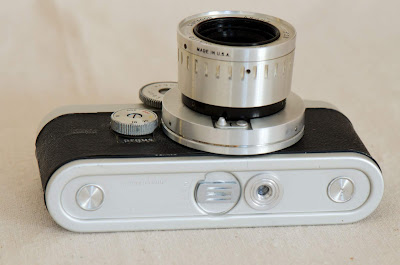This is a Kodak Retina 35 mm camera made in Germany in 1935. The lens is an uncoated f/3.5 50 mm Schneider Xenar in a Deckel Compur-Rapid shutter. The Xenar is a Tessar type lens design with four elements in three groups. Shutter speeds are 1 second, 1/2, 1/5, 1/10. 1/25, 1/50, 1/100, 1/300 and 1/500 plus B (bulb) and T (time). The aperture settings are f/3.5, 4.5, 5.6, 8, 11 and 16. This camera is a scale focuser and has an enclosed reverse galilean viewfinder. It folds into a compact handful.
Retina 117
This is the first model that was designed to use the Kodak 135 daylight loading cartridge. This is the type of 35 mm film that you can buy today and modern film works fine in this camera.
Eastman Kodak Company had organized Kodak AG to manufacture and sell photographic materials for the continental market, and in 1931 the German Kodak acquired the August Nagel camera factory, keeping Dr. Nagel as the manager and giving him a free hand to design and manufacture high quality products. Dr. Nagel developed a design for a folding 35 mm camera to compete with Leica and Contax, and a pre-loaded film cartridge that would fit the new Retina camera and also the existing Leica and Contax cameras. Previously the Leica and Contax had come with cassettes that the photographer loaded with strips of film inside a darkroom or inside a film changing bag. The new Kodak film came from the factory already loaded in a disposable cartridge (magazine in Kodakese) that would drop right into the camera and was much more convenient. Kodak made various versions of the Retina until 1969, when the precision camera business in West Germany basically collapsed due to competition from Japan.
Unfortunately, the camera in the picture has a jammed focuser and the shutter won’t cock if set on B or T, possibly from being dropped at some point in the past. I think it might be an expensive repair. Right now it can sit on a shelf and look interesting. These are not rare cameras because about 60,000 were made. The list price in 1935 was $57.50, equivalent in buying power to about a thousand dollars in 2018 - not cheap, but about a quarter of the price of a Leica or Contax.
[Update] The focuser turned out to be stiff from old grease and freed up when I worked it back and forth a few times. I've learned that this version of the Compur-Rapid shutter doesn't need to be cocked for the B or T settings to work. On B the shutter is supposed to open when the shutter release is pressed and close when it is released. On T the shutter is supposed to open when the shutter release is pressed and close when the shutter release is pressed a second time. The shutter will open on both B and T, but it won't close again until the shutter is set to one of the regular speeds and cocked. The shutter speeds from 1 second to 1/300 appear to all be the same because the retarding gear isn't engaging. 1/500 appears to be faster because on that setting a stronger mainspring is engaged. The shutter could be just gummed up with old lube. I'm feeling a little more cheerful about it. I've put a roll of film in the camera to test it and if the pictures turn out I might send it out to be repaired.
[Update 2] I quickly ran off 36 exposures - click, click, click - in my back yard. The camera works to the extent that it will make an image on film and doesn't have any light leaks that I noticed. I'm not sure that I will try to make this into a user camera.
[Update 3] The camera has been shipped to Chris Sherlock in New Zealand (retinarescue.com) for service. I will wait and see what he can do.
[Update 4] I received the camera from Chris Sherlock on December 6, 2018. It functions as if it were brand new.
[Update 5] According to Dr David Jentz, a Retina expert, production of the 117 camera was closer to 30,000 units than 60,000, which is still a lot of cameras.
Front, Folded
Back
Top
Bottom
Film Chamber
Old Soul Tattoo, Gallatin, TN

















































